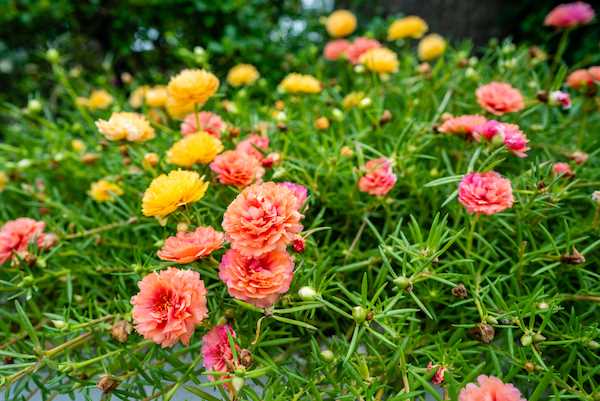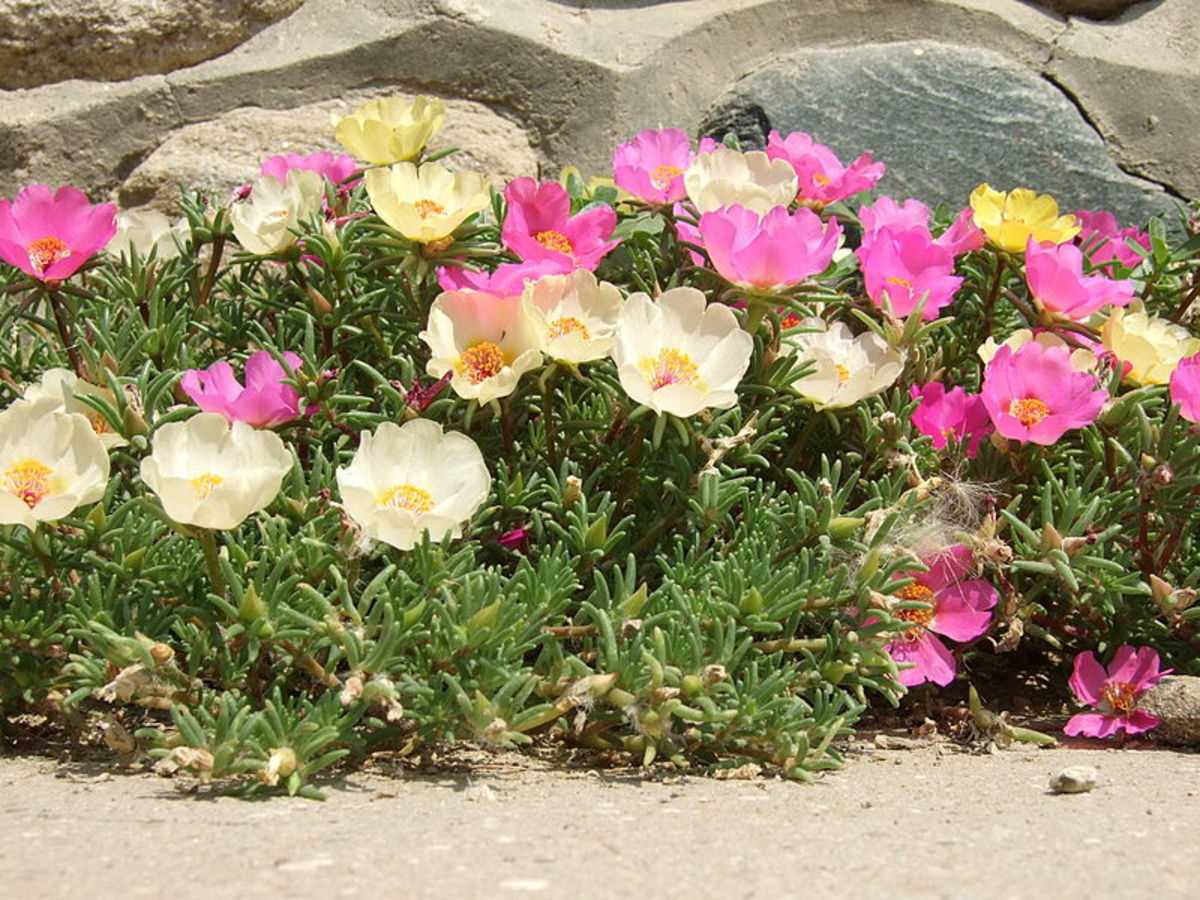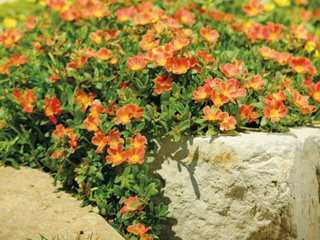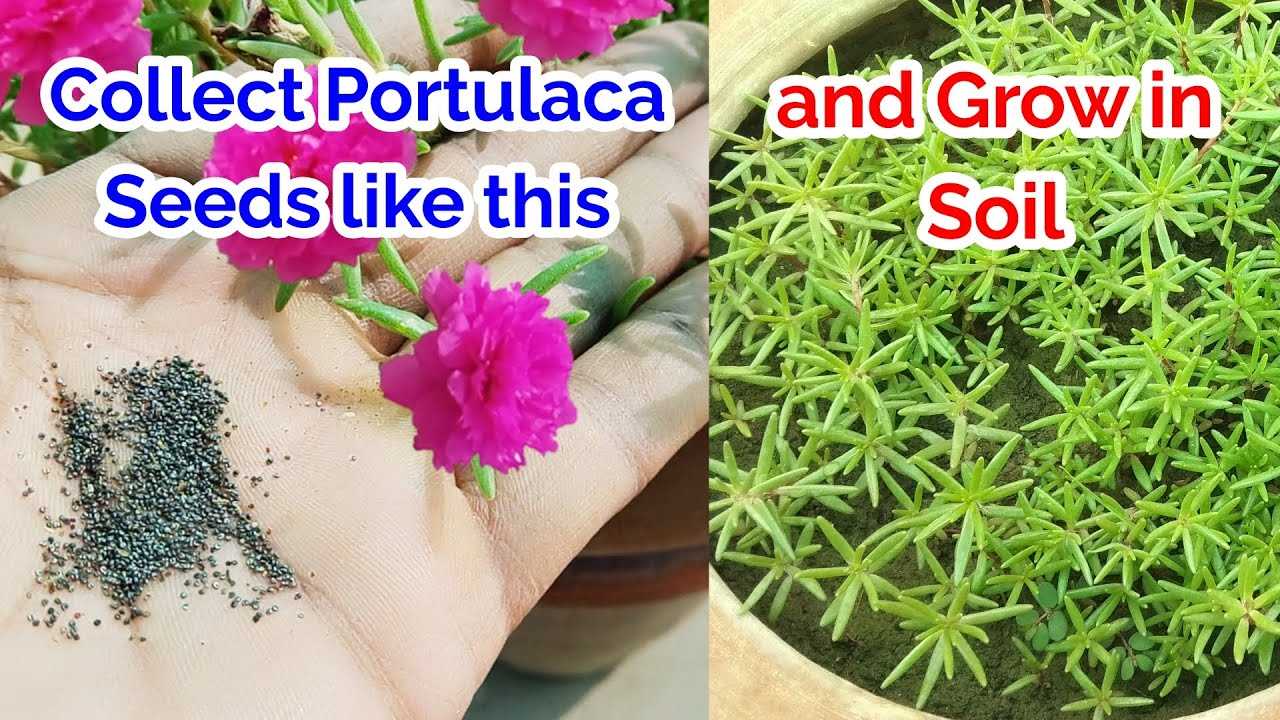- What is Portulaca?
- Benefits of Growing Portulaca in Your Garden
- Choosing the Right Seeds for Portulaca
- 1. Variety
- 2. Seed Quality
- 3. Germination Rate
- 4. Climate Adaptability
- 5. Growth Habit
- 6. Disease Resistance
- Preparing the Soil for Portulaca Seeds
- 1. Choose a well-draining location:
- 2. Remove any existing weeds or vegetation:
- 3. Loosen the soil:
- 4. Amend the soil:
- 5. Level the soil:
- 6. Water the soil:
- Sowing Portulaca Seeds
- Caring for Portulaca Seedlings
- 1. Watering
- 2. Sunlight
- 3. Fertilizing
- 4. Pinching
- 5. Mulching
- 6. Pest and Disease Control
- 7. Transplanting
- Harvesting and Using Portulaca
- Harvesting:
- Using Portulaca:
- Culinary Uses:
- Medicinal Uses:
- Ornamental Uses:
- Questions and Answers:
- What is Portulaca?
- Can I grow Portulaca in my garden from seeds?
- How should I prepare the soil for growing Portulaca?
- When is the best time to sow Portulaca seeds?
- How long does it take for Portulaca seeds to germinate?
- Videos: How To Grow Portulaca Or Moss Rose From Seeds-Full Information From Seed To Flower
Portulaca, also known as moss rose or purslane, is a beautiful and hardy flowering plant that can add a touch of color to any garden. While it is relatively easy to grow from seed, there are a few key steps you’ll want to follow to ensure success.
First, choose a sunny location for your portulaca seeds. This plant loves the sun and will thrive in full sunlight. Make sure the soil is well-draining, as portulaca does not tolerate wet feet. If you have heavy clay soil, consider amending it with sand or compost to improve drainage.
Once you have prepared your soil, it’s time to sow the portulaca seeds. Scatter the seeds thinly on the soil surface, as they need light to germinate. Lightly press the seeds into the soil, but do not cover them completely. Water gently, being careful not to wash the seeds away.
Note: Portulaca seeds are tiny, so it’s a good idea to mix them with sand or fine vermiculite before sowing. This will help you scatter them more evenly and will make them easier to handle.
Keep the soil consistently moist until the seeds germinate, which usually takes about 7-10 days. Once the seedlings appear, thin them out to give each plant enough space to grow. Portulaca plants can spread up to 12 inches, so make sure to give them enough room.
Water your portulaca plants regularly, but be careful not to overwater them. They are drought-tolerant and prefer to dry out between waterings, so a deep watering once a week should be sufficient. Fertilize with a balanced liquid fertilizer every 2-3 weeks to ensure healthy growth and abundant blooms.
In conclusion, growing portulaca from seed is a rewarding process that can result in a stunning addition to your garden. By following these simple steps and providing proper care, you can enjoy the beauty of portulaca flowers all summer long.
What is Portulaca?
Portulaca, also known as moss rose or purslane, is a flowering plant that belongs to the family Portulacaceae. It is a drought-tolerant annual plant that is native to South America but has been cultivated worldwide for its vibrant and showy flowers.
Portulaca flowers come in a range of colors, including pink, red, orange, yellow, and white. The flowers have five petals and can be single or double-flowered. They bloom from summer to fall, attracting bees, butterflies, and other pollinators.
Portulaca plants are known for their succulent leaves, which are thick and fleshy. The leaves can vary in shape and size, but they are typically cylindrical or needle-like. The plant can grow to a height of 6 to 8 inches and spread up to 12 inches, making it an excellent choice for ground cover or container gardening.
One of the benefits of growing portulaca is its ability to thrive in hot and dry conditions. It is well-suited for xeriscaping and can tolerate poor soil, making it an ideal choice for gardeners with challenging growing conditions.
Portulaca can be grown from seeds, which are small and black, resembling tiny pebbles. The seeds can be sown directly into the soil after the danger of frost has passed. With proper care and watering, the seeds will germinate within a week or two, and the plant will start to flower within a few months.
Benefits of Growing Portulaca in Your Garden
- Low Maintenance: Portulaca is a low-maintenance plant that requires minimal care once established.
- Drought Tolerant: Portulaca is known for its ability to thrive in dry conditions, making it a perfect choice for gardens with limited water availability.
- Colorful Blooms: Portulaca produces vibrant and attractive flowers in various shades, including pink, purple, orange, yellow, and white, adding a splash of color to your garden.
- Attracts Pollinators: The flowers of Portulaca are irresistible to bees, butterflies, and other beneficial pollinators, helping to create a more biodiverse and sustainable garden ecosystem.
- Ground Cover: Portulaca spreads quickly and forms a dense carpet of foliage, making it an excellent ground cover that helps to reduce weed growth and soil erosion.
- Heat Tolerant: Portulaca thrives in hot and sunny environments, making it a great choice for gardens in regions with high temperatures.
- Long Blooming Season: Portulaca blooms for an extended period, providing continuous color and beauty to your garden throughout the summer months.
- Versatile: Portulaca can be grown in various settings, including containers, hanging baskets, rock gardens, and flower beds, making it a versatile plant that can be incorporated into any garden design.
- Easy to Grow from Seed: Growing Portulaca from seed is a straightforward and rewarding process, making it an ideal plant for beginner gardeners.
- Edible Flowers: Some varieties of Portulaca have edible flowers that can be added to salads or used as a garnish, adding a unique and delicious touch to your meals.
In conclusion, growing Portulaca in your garden offers numerous benefits, from its low maintenance nature and drought tolerance to its colorful blooms and ability to attract pollinators. Whether you’re looking for a ground cover or an eye-catching addition to your garden, Portulaca is a versatile plant that is sure to enhance your outdoor space.
Choosing the Right Seeds for Portulaca
When it comes to growing Portulaca from seed in your garden, choosing the right seeds is essential for successful cultivation. Here are some factors to consider when selecting Portulaca seeds:
1. Variety
Portulaca comes in various colors and sizes, so it’s important to choose a variety that suits your preferences and garden design. Whether you prefer vibrant reds, pinks, yellows, or a mix of colors, there is a Portulaca variety to match.
2. Seed Quality
Ensure that the seeds you choose are of good quality. Look for reputable seed suppliers or nurseries that specialize in Portulaca seeds. High-quality seeds are more likely to germinate and produce healthy plants.
3. Germination Rate

Check the germination rate of the seeds you are considering. Germination rate indicates the percentage of seeds that can be expected to germinate and grow into healthy plants. Choose seeds with a high germination rate for better success.
4. Climate Adaptability
Consider the climate in your area and choose Portulaca seeds that are well-suited to your specific climate. Some varieties may be more tolerant of heat, drought, or cold than others. Select seeds that can thrive in your local conditions.
5. Growth Habit
Take into account the growth habit of the Portulaca variety you are interested in. Some varieties grow low and spreading, making them great for ground cover or rock gardens. Others have an upright growth habit, making them suitable for containers or borders.
6. Disease Resistance
While Portulaca is generally a hardy plant, some varieties may have better resistance to certain diseases or pests. Look for seeds that have been bred for disease resistance, especially if you have experienced issues with diseases or pests in your garden.
By considering these factors and taking your specific gardening conditions into account, you can choose the right seeds for growing Portulaca in your garden. With proper seed selection and care, you can enjoy the beauty of Portulaca flowers in your outdoor space.
Preparing the Soil for Portulaca Seeds
Before planting portulaca seeds, it is important to prepare the soil to create the optimal growing conditions for these colorful and vibrant flowers. The following steps will guide you in preparing the soil for planting portulaca seeds:
1. Choose a well-draining location:

Portulaca plants thrive in well-draining soil, so it is essential to select a location that allows excess water to drain away. Avoid areas with compacted or heavy clay soil, as these can lead to waterlogging and root rot.
2. Remove any existing weeds or vegetation:
Prior to planting, remove any existing weeds or vegetation from the planting area. Weeds can compete for nutrients and water, hindering the growth of your portulaca plants.
3. Loosen the soil:
Using a garden fork or tiller, loosen the soil to a depth of about 6-8 inches. This will help improve the soil structure and promote better root development.
4. Amend the soil:

If your soil is heavy or lacks nutrients, consider amending it with organic matter. Add compost or well-rotted manure to improve the soil’s fertility and drainage. Work the amendments into the soil thoroughly, ensuring they are evenly distributed.
5. Level the soil:
After amending the soil, level the surface using a garden rake, removing any large clumps or debris. A level and smooth soil surface will provide an even and consistent environment for your portulaca seeds to germinate and grow.
6. Water the soil:
Prior to planting, water the soil thoroughly to provide the initial moisture for the portulaca seeds. This will help them establish and encourage faster germination.
Following these steps will help create an ideal soil environment for portulaca seeds to grow and flourish. Remember to provide adequate sunlight and regular watering to ensure healthy growth of your portulaca plants.
Sowing Portulaca Seeds
Portulaca seeds can be sown directly in your garden or started indoors and transplanted later. Here are the steps to successfully sow portulaca seeds:
- Choose a location: Portulaca thrives in full sun and well-drained soil. Select a spot in your garden that receives at least 6 hours of sunlight daily.
- Prepare the soil: Portulaca prefers sandy or loamy soil. Make sure the soil is well-draining by adding sand or organic matter if necessary.
- Sow the seeds: Gently scatter the portulaca seeds on top of the prepared soil. Keep in mind that portulaca seeds are very small, so you may want to mix them with some sand to help with even distribution.
- Cover the seeds: Lightly press the seeds into the soil, but do not cover them with a thick layer of soil. Portulaca seeds require light for germination.
- Water the seeds: Gently water the area with a fine mist or a gentle watering can. Avoid overwatering, as portulaca prefers dry conditions.
- Provide proper care: Keep the soil moist but not saturated until the seeds germinate, which usually takes around 7 to 14 days. Once the seedlings emerge, water them occasionally, allowing the soil to dry out between waterings.
- Thin the seedlings: When the seedlings have grown a few inches tall, thin them out to allow enough space for each plant to grow. Space them about 6 to 8 inches apart.
That’s it! Now you know how to sow portulaca seeds and start growing these beautiful and drought-tolerant plants in your garden.
Caring for Portulaca Seedlings

Once your portulaca seeds have germinated and the seedlings have emerged, it’s important to provide them with the proper care to ensure their healthy growth. Here are some tips on caring for portulaca seedlings:
1. Watering
Portulaca seedlings require regular watering to keep their soil evenly moist. However, it’s important not to overwater them as excessive moisture can lead to root rot. Water the seedlings when the top inch of soil feels dry to the touch. Ensure that the pot or garden bed has good drainage to prevent waterlogged conditions.
2. Sunlight
Portulaca is a sun-loving plant and requires at least 6 hours of direct sunlight each day. Place the seedlings in a sunny spot, preferably in a south-facing location, to ensure they receive adequate sunlight. If growing indoors, provide them with bright, indirect light or use a grow light to supplement their light needs.
3. Fertilizing
Portulaca seedlings benefit from regular feeding with a balanced, water-soluble fertilizer. Start fertilizing them about two weeks after germination and continue every two to three weeks throughout the growing season. Follow the instructions on the fertilizer package for the recommended dosage and dilution ratio.
4. Pinching
To promote bushier growth, you can pinch back the tips of portulaca seedlings once they have developed a few sets of true leaves. Using your thumb and forefinger, gently pinch off the top inch of the stem. This will encourage the plant to send out new side shoots, resulting in a more compact and full appearance.
5. Mulching
Applying a layer of organic mulch around the base of the portulaca seedlings can help conserve soil moisture, suppress weed growth, and regulate soil temperature. Use a mulch such as straw, compost, or shredded leaves, and spread it around the plants, taking care not to cover the stems or foliage.
6. Pest and Disease Control
Portulaca seedlings are generally resistant to pests and diseases. However, they can occasionally be affected by aphids, spider mites, or fungal diseases like powdery mildew. Regularly inspect your seedlings for any signs of infestation or disease, and take appropriate measures to control them. This may include using organic insecticidal soap, neem oil, or other appropriate treatments.
7. Transplanting
If you started your portulaca seedlings indoors, you will need to transplant them outdoors once the danger of frost has passed and the soil has warmed up. Choose a well-drained location with full sun or partial shade. Space the seedlings about 6-8 inches apart to allow for their spreading growth habit.
By following these care tips, you can help your portulaca seedlings thrive and produce vibrant, colorful blooms throughout the growing season.
Harvesting and Using Portulaca

Once your Portulaca plants have matured and bloomed, it’s time to start harvesting and using the plant in various ways. Here are some tips on how to harvest and use Portulaca:
Harvesting:
- Choose a dry and sunny day to harvest Portulaca.
- Gently pluck the flowers or leaves from the plant.
- Make sure to remove any debris or insects before using the harvested parts.
Using Portulaca:
Portulaca can be used for various purposes, including culinary, medicinal, and ornamental uses. Here are some common ways to use Portulaca:
Culinary Uses:

- The flowers and leaves of Portulaca can be consumed raw in salads, adding a crunchy texture and a slightly tangy flavor.
- They can be used as a garnish for soups, stir-fries, and other dishes to add a pop of color.
- Portulaca can also be pickled or used in marinades to enhance the flavor of various dishes.
Medicinal Uses:
- Portulaca has been used in traditional medicine for its various health benefits.
- It is believed to have anti-inflammatory and antioxidant properties.
- Portulaca extracts or teas can be used topically to help soothe skin irritations, such as sunburns or insect bites.
Ornamental Uses:
- The bright and colorful flowers of Portulaca make it a popular choice for ornamental purposes.
- You can use the flowers to create beautiful flower arrangements or bouquets.
- Portulaca can also be grown in decorative pots or hanging baskets to add a vibrant touch to your garden or balcony.
Remember to always do your research and consult with a healthcare professional before using Portulaca for medicinal purposes, as individual results may vary. Enjoy the beauty and versatility of Portulaca in your garden!
Questions and Answers:
What is Portulaca?
Portulaca is a type of flowering plant that belongs to the purslane family. It is also known as moss rose or sun rose.
Can I grow Portulaca in my garden from seeds?
Yes, you can easily grow Portulaca in your garden from seeds. It is a relatively easy plant to grow from seed and can be a beautiful addition to your garden.
How should I prepare the soil for growing Portulaca?
Portulaca prefers well-draining soil, so it is important to prepare the soil accordingly. You can add organic matter, such as compost, to improve the soil’s drainage and fertility. It is also recommended to ensure that the soil is moist before planting the seeds.
When is the best time to sow Portulaca seeds?
The best time to sow Portulaca seeds is in the spring, after the danger of frost has passed. Portulaca is a warm-season plant and prefers warm weather to germinate and grow successfully.
How long does it take for Portulaca seeds to germinate?
Portulaca seeds usually take about 7 to 14 days to germinate. However, the germination time can vary depending on the temperature and conditions in which the seeds are kept. It is important to keep the soil consistently moist during this period to promote successful germination.







